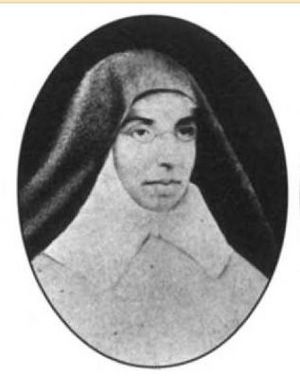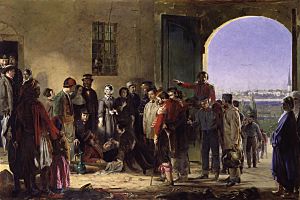Mary Clare Moore facts for kids
Quick facts for kids Mary Clare Moore |
|
|---|---|

Mother Mary Clare Moore
|
|
| Religion | Roman Catholic |
| Order | Sisters of Mercy |
| Personal | |
| Nationality | Irish |
| Born | Georgina Moore 20 March 1814 Dublin, Ireland |
| Died | 13 December 1874 (aged 60) Bermondsey, London, UK |
Mother Mary Clare Moore (born Georgina Moore, 20 March 1814 – 13 December 1874) was an amazing Irish nun, nurse, and teacher. She was one of the first ten members of the Sisters of Mercy. She also became the first leader of their convent in England. Mary Clare Moore is especially remembered for her brave work as a nurse during the Crimean War.
Contents
Early Life and Becoming a Sister
Mary Clare Moore was born Georgina Moore in Dublin, Ireland, on March 20, 1814. She was the youngest of three children. Her family was Protestant at first. After her father passed away in 1817, her mother and siblings, including Georgina, became Catholic in 1823.
Georgina had a private education. Later, she worked as a governess, teaching children in their homes. In 1828, she started working for relatives of Catherine McAuley. Catherine McAuley was the founder of the Sisters of Mercy. While working there, Georgina became interested in helping others through the House of Mercy.
On January 23, 1832, Georgina officially joined the Sisters of Mercy. She became known as Sister Mary Clare. A year later, on January 24, 1833, she made her final vows.
Helping Others: A Life of Service
Sister Mary Clare dedicated her life to helping people. She nursed those suffering from the 1832 cholera outbreak in Dublin. Cholera was a very serious illness at the time.
Leading the Way in England
In 1837, Sister Mary Clare became the leader of the Sisters of Mercy convent in Cork, Ireland. There, she helped train new nuns from England. These nuns were preparing to open the first Sisters of Mercy convent in England. This new convent was in Bermondsey, London.
Sister Mary Clare became the first leader of the Bermondsey convent when it opened in 1839. She later returned to Cork but came back to Bermondsey permanently in 1841. In London, she and the other sisters visited poor people in their homes. They also helped patients in big hospitals like St Thomas's and Guy's Hospitals. They taught adults who were new to the Catholic faith or who had stopped practicing it. The sisters also helped provide schooling for children from poorer families.
Heroic Work in the Crimean War
In 1854, a war called the Crimean War was happening. British soldiers were fighting far from home. Bishop Thomas Grant asked Sister Mary Clare and four other sisters to go to Crimea to nurse sick and wounded soldiers.
They left London on October 17, 1854. Their group traveled just before Florence Nightingale and her nurses. In Paris, Sister Mary Clare visited hospitals to learn more about nursing. She also gathered important medical supplies and tools. These items were very helpful in the field hospitals later on.
On November 4, the groups arrived in Constantinople (modern-day Istanbul, Turkey). Sister Mary Clare took charge of the supplies, kitchens, and helpers in the hospitals. Florence Nightingale's group and the other sisters cared for 2,500 wounded soldiers in a former Turkish army building that was turned into a hospital.
In 1855, Sister Mary Clare worked at a hospital in Scutari, Turkey. She nursed soldiers during a serious outbreak of cholera. Other Sisters of Mercy, like Mother Mary Francis Bridgeman and Sister Aloysius Doyle, worked alongside her.
Sister Mary Clare became very ill and returned to London on April 28, 1856. Florence Nightingale greatly admired Sister Mary Clare's nursing skills. She wrote a letter praising her qualities. Sister Mary Clare and Florence Nightingale remained friends for their entire lives. Sister Mary Clare is even shown in a famous painting called The Mission of Mercy. This painting shows Nightingale helping a wounded soldier at the Barrack Hospital.
Later Life and Legacy
In 1868, Sister Mary Clare helped publish a book called The Practical Sayings of ... Catherine McAuley. This book shared important ideas from the founder of the Sisters of Mercy.
Mother Mary Clare Moore passed away at the Convent of Mercy in Bermondsey on December 13, 1874. She is buried in the convent cemetery. When she was dying, Florence Nightingale wrote that "It is we who are left mother-less when she goes." This shows how much Nightingale respected and admired her friend.
Convents Founded by Mary Clare Moore
Sister Mary Clare Moore helped start eight new convents (religious communities) for the Sisters of Mercy in England:
- Chelsea (1845)
- Bristol (1846)
- Brighton (1852)
- St John's and Elizabeth's Hospital, London (1856)
- Wigton (1857)
- Abingdon (1860)
- Gravesend (1860)
- Clifford (1870)
- A branch convent and House of Mercy in Eltham (1874)


